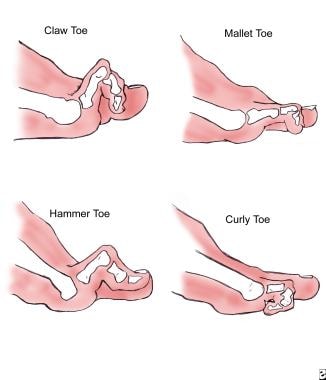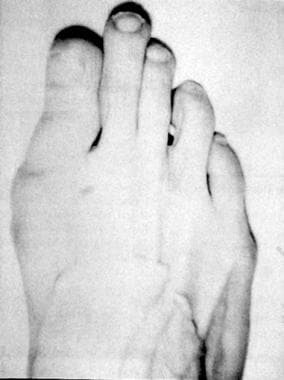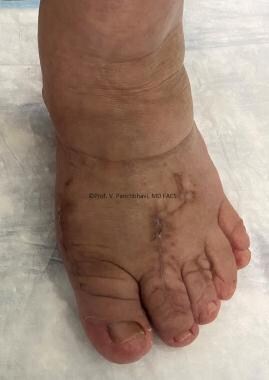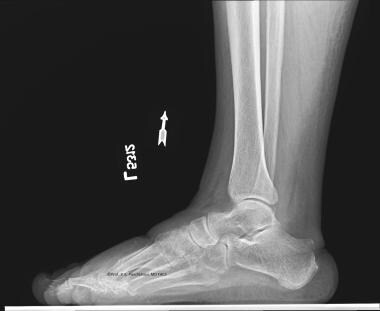Practice Essentials
Hammertoe deformity is the most common deformity of the lesser toes. The fundamental problem is a chronic, sustained imbalance between flexion and extension forces applied to the lesser toes. These imbalanced forces involve intrinsic and extrinsic tendons of the foot.
With progressive proximal interphalangeal (PIP) joint flexion deformity, compensatory hyperextension of the metatarsophalangeal (MTP) and distal interphalangeal (DIP) joints typically occurs. The hyperextension of the MTP joint and the flexion of the PIP joint make the PIP joint prominent dorsally. This prominence rubs against the patient's shoe and may progress to cause discomfort.
Early in its natural history, the deformity is flexible and passively correctable, but it typically becomes fixed over time. Progressive deformity can lead to MTP joint dislocation. Nonoperative treatment may include the following:
-
Taping
-
Budin splint wear
-
Shoewear modification (with some patients going so far as to cut holes in shoes over the prominence)
Once flexion contractures form, surgical treatment may be indicated. Surgical treatment of hammertoe deformity has historically been based on altering the relative lengths of the toe and its tendons in order to achieve balance between extensor and flexor forces. A main distinction is between the flexible and the rigid hammertoe deformity. Surgical options have included the following:
-
PIP joint resection arthroplasty
-
PIP joint fusion
-
Tendon transfers
-
Tendon lengthening
-
Metatarsal shortening
Metatarsal shortening has gained renewed interest, but PIP joint resection arthroplasty and tendon transfers have been the main procedures for hammertoe correction.
Anatomy
The lesser toe comprises three phalanges that articulate at the PIP and DIP joints. The proximal phalanx articulates with the metatarsal at the MTP joint. Medial and lateral collateral ligaments, a fibrocartilaginous plantar plate, and a thin dorsal capsule stabilize each of the three joints.
The extensor digitorum longus (EDL) tendon originates in the anterior compartment of the leg and crosses the ankle anteriorly. Although it extends all three joints of the lesser toe, it primarily acts at the MTP joint. The extensor digitorum brevis (EDB) originates at the dorsal surface of the calcaneus and blends with the EDL tendon over the proximal phalanx to form the extensor expansion.
The EDL continues distally from the extensor expansion and trifurcates to form the central slip, which inserts onto the middle phalanx, and the lateral slips, which insert onto the distal phalanx and are distinguished by their anatomic location (medial or lateral). The central slip and lateral bands extend the PIP and DIP joints, respectively, when the MTP joint is in neutral position or in plantarflexion. Some authors have found that the lateral slips arise from the EDB tendon in toes 2 through 5. [1, 2]
The flexor digitorum longus (FDL) tendon originates in the deep posterior compartment of the leg, crosses the ankle medially, and flexes all three joints of the lesser toes, though it acts primarily at the DIP joint. The flexor digitorum brevis (FDB) tendon originates from the plantar surface of the calcaneus and primarily flexes the PIP joint. The lumbricals originate from adjacent FDL tendons, pass plantarly to the MTP, and then extend dorsally to coalesce with the lateral bands. Thus, the lumbricals flex the MTP joint and extend the PIP and DIP joints.
The neurovascular bundles of each toe arise from a common interdigital artery and a common interdigital nerve. Each bifurcates at approximately the level of the MTP joint. Each branch then extends along the medial and lateral aspects of the toe deep to the subcutaneous tissue. Both the interdigital artery and the interdigital nerve are plantar to the intermetatarsal ligament at the level of the MTP joint. Both can become contracted in a chronic hammertoe and are subject to traction injury with hammertoe correction.
Pathophysiology
The fundamental problem is a chronic, sustained imbalance between flexion and extension force of the lesser toes from intrinsic forces, extrinsic forces, or both. Hammertoe deformity primarily involves flexion deformity of the PIP joint of the toe, with hyperextension of the MTP and DIP joints (see the image below).
When the second ray of the foot is longer than the first and shoewear is improperly fitted, flexion of the PIP joint occurs to accommodate the shoe. This length difference also causes MTP synovitis to develop from overuse of the second MTP joint. Attenuation of the collateral ligaments and plantar plate results, and the MTP joint hyperextends and may even progress to dorsal subluxation or dislocation (see the image below). Rheumatoid arthritis causes hammertoe deformity by progressive MTP joint destruction, leading to MTP joint subluxation and dislocation. [3, 1, 4]
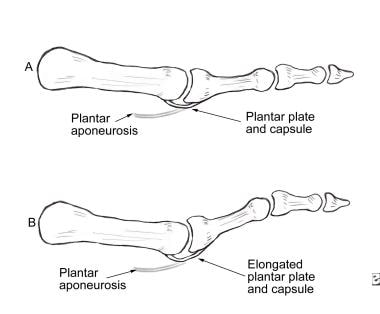 Pathomechanics of hammertoe deformity. Elongated plantar plate, caused by either metatarsophalangeal (MTP) synovitis and instability or chronic MTP hyperextension due to toe crowding, results in MTP subluxation or dislocation with compensatory proximal interphalangeal (PIP) flexion.
Pathomechanics of hammertoe deformity. Elongated plantar plate, caused by either metatarsophalangeal (MTP) synovitis and instability or chronic MTP hyperextension due to toe crowding, results in MTP subluxation or dislocation with compensatory proximal interphalangeal (PIP) flexion.
With all three of these etiologies, the EDL tendon gradually loses mechanical advantage at the PIP joint, as does the FDL tendon at the MTP joint. The intrinsic muscles subluxate dorsally as the MTP hyperextends. They now extend the MTP joint and flex the PIP joint, as opposed to their usual functions of flexing the MTP joint and extending the PIP joint.
Etiology
Etiologies of hammertoe deformity include the following:
-
A foot in which the second ray is longer than the first (see the image below)
-
MTP joint synovitis and instability
-
Inflammatory arthropathies
-
Neuromuscular conditions
-
Ill-fitting shoewear
MTP joint synovitis and instability are associated with a second ray that is longer than the first. Inflammatory arthropathies typically involve more than one of the lesser MTP joints. Ill-fitting shoewear compounds the effects of any of the other causes.
Epidemiology
The incidence of hammertoe deformity is undefined. However, the condition is strongly associated with the presence of a second ray that is longer than the first, and it is known to be more common in women and to increase in frequency with advancing age. Indeed, this length disparity is found in most patients presenting with foot complaints, though the actual prevalence of this foot shape also is undefined.
Prognosis
Patients should be counseled that their expectations for a good result after hammertoe treatment should include the following:
-
Permanent relief of pain
-
Ability to wear reasonable shoes (those of appropriate length, width, and depth for their entire foot) without pain
Although nonoperative treatment of hammertoe deformity often successfully alleviates pain, the deformity typically progresses in magnitude and stiffness despite diligent nonoperative care. Surgical treatment of flexible hammertoe deformity reliably corrects the deformity and alleviates pain. Recurrence and progression are common, especially if the patient resumes wearing deforming shoes. Surgical treatment of fixed hammertoe deformity provides very reliable deformity correction and pain relief. Recurrence is rare after appropriate surgical management. (See the images below.)
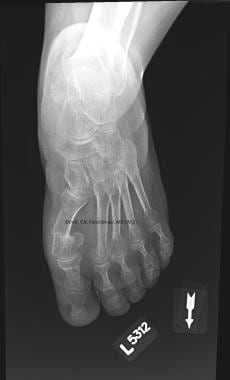 Anteroposterior radiograph at 3-month follow-up showing correction of hammertoe and hallux valgus deformities.
Anteroposterior radiograph at 3-month follow-up showing correction of hammertoe and hallux valgus deformities.
Mueller et al evaluated outcomes of operative management of hammertoe deformity in 47 patients, of whom 26 (37 toes) were younger than 65 years and 21 (39 toes) were 65 years of age or older. [5] They found that both groups showed statistically significant improvement, that the two cohorts were similar with respect to outcomes, and that there was no significant increase in complications in the older patents.
-
Diagram comparing clinical appearances of lesser-toe deformities.
-
Morton foot, wherein second ray (metatarsal and corresponding toe) is longer than first ray.
-
Pathomechanics of hammertoe deformity. Elongated plantar plate, caused by either metatarsophalangeal (MTP) synovitis and instability or chronic MTP hyperextension due to toe crowding, results in MTP subluxation or dislocation with compensatory proximal interphalangeal (PIP) flexion.
-
Painful dorsal callus over proximal interphalangeal (PIP) joint of second toe, caused by long-standing, fixed hammertoe deformity.
-
Physical examination maneuver to diagnose metatarsophalangeal (MTP) instability, wherein examiner attempts to translate proximal phalanx dorsally relative to metatarsal head. In most patients, subluxation is possible; therefore, this test is positive only when it causes pain.
-
Hammertoe shield for treatment of flexible hammertoe. Sling over proximal phalanx straightens toe, while shield under metatarsal head provides padding for painful callus that may be present, supports toe plantarly, and anchors sling.
-
Severe hammertoe deformity in second toe overlapping great toe with associated hallux valgus deformity.
-
Anteroposterior radiograph showing hammertoe deformity in second toe and associated hallux valgus deformity in forefoot.
-
Lateral radiograph showing hammertoe deformity.
-
Intraoperative fluoroscopic image showing correction of deformities in first and second rays and use of Kirschner wires to stabilize osteotomies.
-
Anteroposterior radiograph at 3-month follow-up showing correction of hammertoe and hallux valgus deformities.
-
Lateral radiograph at 3-month follow-up showing correction of lesser-toe deformity.
-
Clinical photograph showing correction of deformities involving second and great toes.
-
"Sausage toe" complication occurring after Girdlestone-Taylor tendon transfer.

